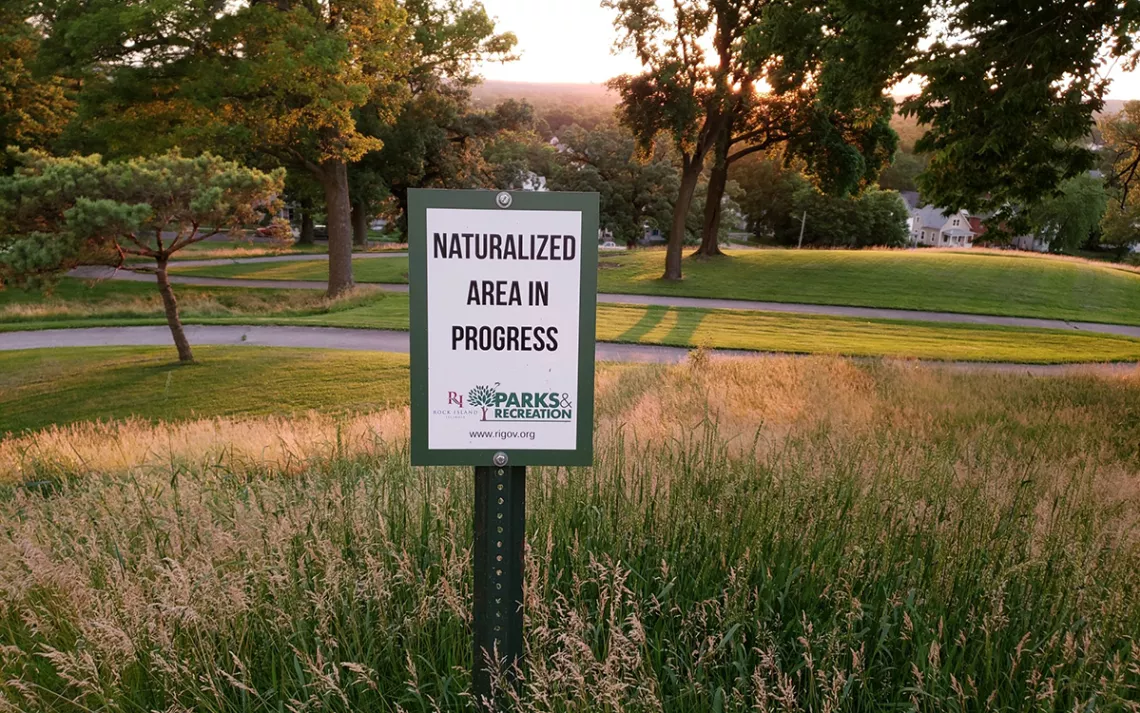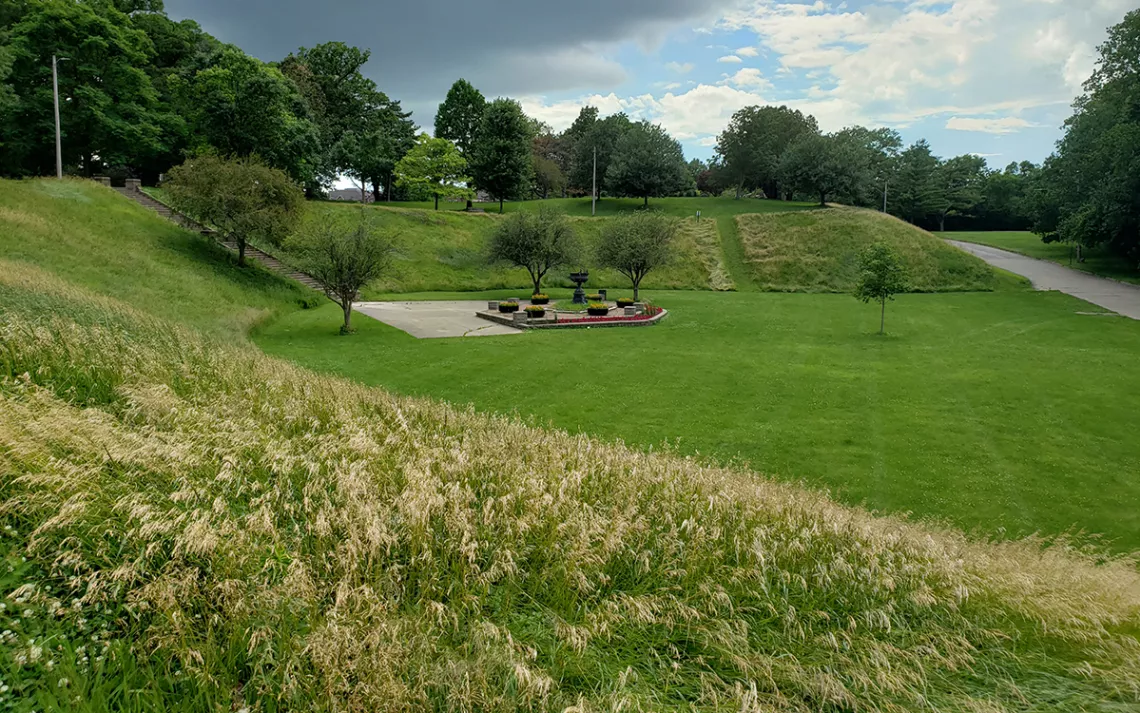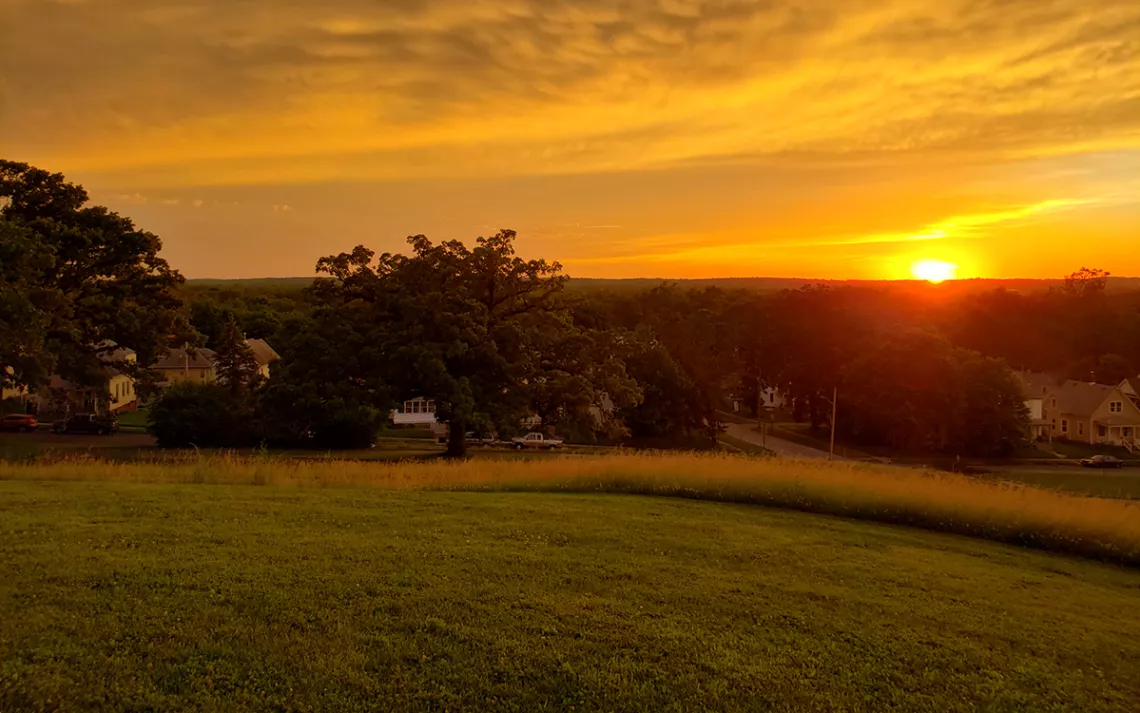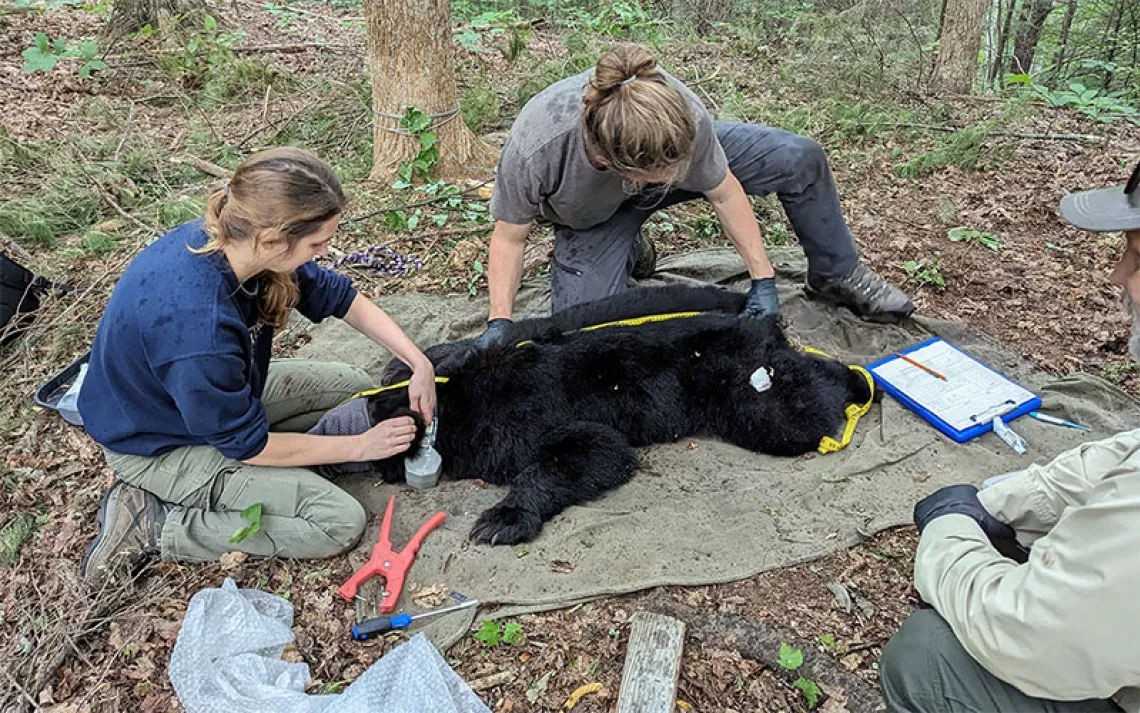When Rewilding Confronts Common Perceptions of Nature
Inside the Illinois park where prairie restoration efforts sparked outrage

Photos courtesy of Christian Elliott
It’s mid-July and in a park overlooking the Mississippi River in Rock Island, Illinois, change is afoot. Parkgoers are taking note of the fact that all across Lincoln Park’s rolling hills, invasive Kentucky bluegrass grows unrestrained, its golden stalks waving gently in the hot breeze. Every year for as long back as Rock Islanders can remember, the Parks and Recreation Department had mowed it. Now, apparently, they had given up.
As I walk along an oak-lined park path, audio recorder in hand, an elderly Rock Islander and his wife ask me to plead their case to the city. He gestures at a small sign planted at the edge of a one-acre patch of overgrown grass that reads “Naturalization in Progress.”
“No one’s taking care of this park,” he says. “They don’t mow the slopes anymore—they say they want it to go back to prairie, but it just looks unkempt.”
“It just looks like an abandoned place,” his wife agrees.
When they finish airing their grievances, I switch off my recorder, thank them for their time, and head home to transcribe the interview—yet another in which I’m surprised to hear my interviewees express disgust at the naturalization of their park.
For the past two months, I’d spent every day in Lincoln Park, interviewing recreators and park managers, distributing surveys, and conducting structured observations and visitor counts at all times of the day. I’d decided to do an ethnography of Lincoln Park for my sociocultural anthropology thesis after I heard of the city’s decision to “rewild” or naturalize significant portions of its long-manicured urban parks. How had prairie restoration—a cutting-edge environmental management strategy more commonly used in large state-owned refuges and big cities—come to be implemented by a small parks department here in Rock Island? And how would Rock Islanders handle the sudden introduction of wild-looking nature into their parks?

Business-minded park management
A city of about 37,000 in far western Illinois, Rock Island boasts 850 acres of public green space in 28 parks of various sizes, plus two golf courses, a water park, an outdoor sports complex, and a fitness center. Parks department staff members I interviewed were quick to state that Rock Island features more “parks per capita” than any nearby community of similar size.
Recent research shows that urban parks have the potential to buffer negative climate effects through ecosystem services and ameliorate social problems like obesity and social isolation—the latter being increasingly problematic in an era of rapid urbanization, a changing climate, and political division. Yet, while urban parks are asked to provide these services for cities, parks departments across the country are facing significant fiscal pressures, and public green space investment is frequently a first target for spending cuts—as is the case in Rock Island. “We are blessed to have our parks,” parks department director John Gripp told me. “But sadly, we don’t have enough money to maintain them the way I would like to see them maintained.”
Ever since the “long downtown” of downscaling and deindustrialization began in the Rust Belt–adjacent city in the 1980s, local government has faced acute deficit crises and declining property tax revenues that have led to massive cuts in public sector funding (especially for parks) and increased privatization. In fact, Rock Island’s “more parks per capita” narrative is continually framed negatively in city budget discussions.
Gripp told me that the department has had to operate in a “culture of scarcity,” making significant staffing cuts, contracting park mowing to private companies, and prioritizing maintenance on revenue-generating properties like the golf courses over older and lesser-used properties—like Lincoln Park. Illinois’s planned minimum wage increase and more frequent flooding in parks adjacent to the Mississippi due to climate change, he says, promise to provide continual challenges to management going forward.

Prairie restoration: an unlikely austerity measure
It was these policies of fiscal austerity, Gripp told me, that led the department to the creative cost-saving management intervention that has Rock Islanders so upset: naturalization. The reintroduction of native prairie grasses and forbs (flowers) to urban parks is an “industry-wide trend” that fits well with the department’s business-minded approach. Furthermore, it’s a sustainable, incremental, realistic response to the budget crisis.
Only 2,500 acres of tallgrass prairie remain in Illinois today, out of 22 million that once covered the state. Before the Sauk and Meskwaki tribes were forced out of its rolling hills by the federal government, the area that is now Lincoln Park likely contained prairie. As a result, prairie restoration in Lincoln Park, implemented correctly, could be an effective environmental conservation measure that also functions as “plant advocacy,” helping to “decolonize” settler-colonial landscapes (transitioning European-style manicured lawns back to the prairies Indigenous people carefully managed before colonization). Furthermore, naturalization promises economic benefits for the city—saving the austerity-minded department cash on stormwater management and mowing while increasing their eligibility for grants and attracting environmentally minded visitors and school groups.
Gripp told me that 11 acres—mostly on hillsides and other “unused” areas of the park—were selected for “re-wilding” in 2019. That process, so far, has consisted of “letting them go” and mowing twice a year, parks department chief horticulturalist Marcus DeMarlie told me. While the grass has been left to grow, city aldermen and parks department employees have fielded a lot of calls from residents who just want the city to mow again. The problem, DeMarlie told me, is that “naturalization is not an overnight process.” Proper prairie restoration typically involves regular controlled burns and native plant seeding on a continuous basis indefinitely.
While native seeding efforts are confined to small test plots, the department is committed to expanding prescribed burning, Gripp said. His staff has been certified by the city and state of Illinois and he’s partnered with nearby Black Hawk State Park and the Rock Island County Forest Preserve to share equipment. In 2020, with a grant from local nonprofit River Action, fire returned to Lincoln Park’s reborn prairie for the first time in centuries.
Still, studies out of nearby Augustana College have shown the re-wilding has been chaotic and uncontrolled so far—most of the naturalized areas contain only invasive shrubs and Kentucky Bluegrass. Without aesthetically pleasing prairie flowers and grasses present, DeMarlie told me, increasing public support will be difficult. Native seeds (and the labor required to plant and maintain them) aren’t cheap, though, and fires in an urban area are a hard sell. A concerted education campaign by the parks department, coupled with a continuing commitment to undertaking prairie restoration properly, could likely sway public opinion. By why is public opinion so negative?
Based on many interviews, Rock Islanders’ views on park naturalization—and their justifications for them—are complicated, to say the least. Some question John Gripp’s motivations, accusing him of trying to save a buck, not improve the park’s ecological quality. Many others complain that the naturalized areas look “patchy,” “trashy,” “too wild,” or “unkempt.” The overgrown grass gives them “an icky feel” or looks “very, very not inviting.” These reactions have a more deeply ingrained basis.
All parkgoers possess preconceived ideas about what defines “nature” and the role it should have in public parks. They have expectations for how nature bounded by the culture of the city should look—expectations rooted in a Western idea of a division between humans and nature and shaped by a lifetime of experiencing urban parks with close-cropped lawns modeled after European pleasure gardens. Given this background, it’s easy to see why naturalization feels like an invasion—wilderness transgressing established boundaries and changing a park that’s looked the same way for hundreds of years.
In the months and years to come, the Rock Island Parks and Recreation Department will have an important role to play in helping residents see Lincoln Park not as a publicly accessible extension of their own manicured lawns, but instead as a new kind of nature—one critically important to the future sustainability of the city that they all have a role in stewarding. Residents, understandably, fear the park’s dramatically changing aesthetic, however this new paradigm in park management allows for adaptation, both to the changing climate and the city’s increasingly precarious financial situation. It’s a slow process and a long-term one without immediately obvious results (the kind notoriously difficult to maintain support for in local government). But given patience, dedication, and time, Rock Island’s parks could bloom in a way that has not been seen here for hundreds of years—showcasing all the colors of the prairie.
 The Magazine of The Sierra Club
The Magazine of The Sierra Club



